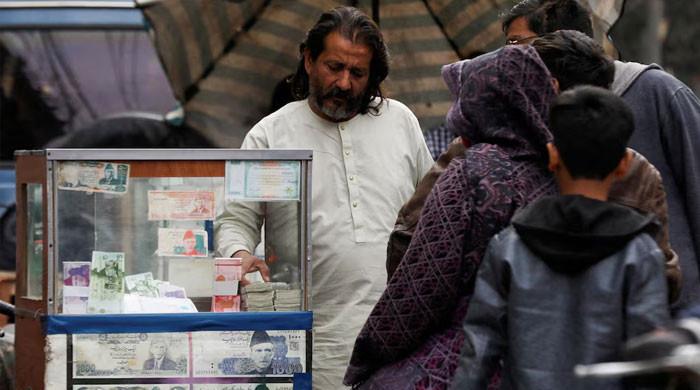When Pakistan began another financial year this month, in the midst of widespread skepticism, the country’s rulers presided a sharp contrast between the mood of the streets and their self -proclaimed results.
On the bright side, Pakistan today stands safely away from his dangerous prospects just two years ago, surrounded by warnings of an upcoming breach of refund of foreign debt, while rupe was facing volatility. However, a subsequent return to another IMF locking program has helped Pakistan regain solvency – albeit temporarily.
However, the gap between the mood of the streets and the corridors of power highlights a great dilemma. While Prime Minister Shehbaz Sharif and members of his cabinet claim to lead Pakistan against greater prosperity, there is no shortage of cynics presenting powerful counter -arguments.
Pakistan’s successive rulers have repeatedly failed to follow the warning signs. In a country where almost 40% of the population, or about 100 million people, lives below the poverty line leading Pakistan with a “SUB ACHHA HAI,” or all is good mantra may well trigger a wrong calculation over the future.
In Tandem with this powerful reality lies the deep challenge of climate change, which is widely illustrated by the ongoing rain -related disasters over Pakistan. In this extended trend it is difficult to find a region where monsoon rain has not created an unexpected effect. The changing weather patterns have been a strong reminder that Pakistan’s food security is increasingly in doubt.
The recent downturn in Pakistan’s agricultural production, which grew with a lean 0.6% during the last fiscal year (July 2024-June 2025), deserves carefully attention for more than one reason.
The continued losses in agriculture immediately raise convincing questions over the future of Pakistan’s crop -related cycles that go back for many centuries. It is a relevant question considering the devastating consequences that are sure that flowing in the event of food security problems remains unresolved.
Closely related are the considerable employment and/or income generation options associated with agriculture, making this an important sector of Pakistan’s economy. Unless the poorest farmers’ income has been repealed and effectively protected, Pakistan may be forced to stiffen for a potentially widespread social and financial upheaval in the coming years. In short, Pakistan has to do everything it can to protect those who are already living in poor poverty without hope for the future.
Pakistan’s industrial sector is also surrounded by compelling issues, especially as a large -scale production, which was entered into with 1.6% during the last financial year. Currently, the improvement in Pakistan’s current account was mainly facilitated by transfers from posted Pakistanis living worldwide. It is a continued trend that has helped the country to remain fluid.
Nevertheless, a guarantee of protecting Pakistan’s ability to fulfill its obligations in foreign currency must eventually be tied to a robust increase in exports supported by a number of sources. On this journey, diversification of exports ranging from agriculture profits to the industrial sector, is an absolute must.
And in the end, this week’s official fanfare deserves behind the launch of a simplified fiscal archiving system for employee individuals a closer control. The largest hole in tax collections is not with Pakistan’s already loaded grade. Instead, it surrounds key sectors of the economy that either do not contribute to Pakistan’s national income tax or contribute significantly under their quota.
Time and time again, Pakistan has been reminded of such holes, which are mainly driven by the lack of the country’s leaders to enforce the state’s writing. But given the multifaceted challenges of Pakistan’s financial front, it is now important to change the past in favor of a more progressive future.
Ultimately, Pakistan’s ability to overcome its current financial challenges in its capacity to implement long -term reforms strongly. These reforms will succeed when Pakistan’s leaders establish a clear path forward and lead as an example. The government presides over an inflated public sector and has monitored two recent cases that sent an unfavorable message.
First, the reason for reviving the state -owned Pakistan International Airlines (Pia) responded to bringing a dead horse back to life. Even if it is eventually privatized, Pia’s large debt reportedly remains in the government’s account as a responsibility. It is a case that instantly reminds one of a recommendation from well -known businessman Mian Mian Mohammad Manssha. Many years ago, he publicly called for the immediate privatization of Pia, even for a single US dollar, provided its new owner assumed all his obligations, including the debt.
Secondly, the recently revealed plan to revive the Karachi-based Pakistan Steel Mills with Russia’s support yet another case marking a U-turn. Should Pakistan expand his footprint in the public sector considering the way its finances have worsened under the weight of state -owned companies? To the compelling question, the answer must clearly be negative.
Disclaimer: The views expressed in this piece are the author’s own and does not necessarily reflect Pakinomist.tv’s Editorial policy.
The author is an Islamabad-based journalist who writes about political and economic affairs. He can be reached at: [email protected]
Originally published in the news



